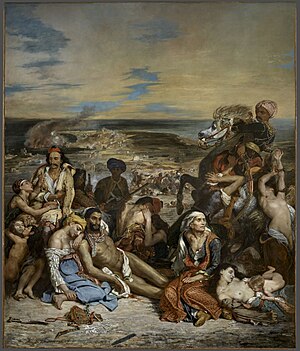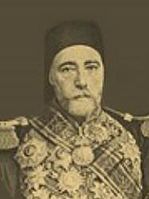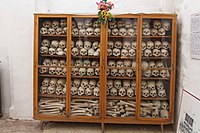Chios massacre
Details
| Part of Massacres during the Greek War of Independence | |
| Location | Chios, Ottoman Empire |
|---|---|
| Coordinates | 38°21′50″N 26°03′47″E / 38.3640°N 26.0630°ECoordinates: 38°21′50″N 26°03′47″E / 38.3640°N 26.0630°E |
| Date | April-August 1822 |
| Deaths | 42,000–52,000[unreliable source?] |
| Perpetrators | Ottoman military |
Sources
Chios massacre
Introduction
The Chios massacre (in Greek: Η σφαγή της Χίου, Greek pronunciation: [i sfaˈʝi tis ˈçi.u]) was the killing of tens of thousands of Greeks on the island of Chios by Ottoman troops during the Greek War of Independence in 1822. Greeks from neighboring islands had arrived on Chios and encouraged the Chiotes to join their revolt. In response, Ottoman troops landed on the island and killed thousands. The massacre of Christians provoked international outrage and led to increasing support for the Greek cause worldwide.
Background
For over 2,000 years, Chios merchants and shipowners had been prominent in trade and diplomacy throughout the Black Sea, the Aegean, and the Mediterranean. The Ottoman Empire allowed Chios almost complete control over its own affairs as Chioten trade and the very highly valued mastic plant, harvested only on Chios, were of great value to it. The cosmopolitan Chiotes were also very prominent in Constantinople. Following the massacre, however, the island never regained its commercial prominence.
The island's ruling classes were reluctant to join the Greek revolt, fearing the loss of their security and prosperity. Furthermore, they were aware that they were situated far too close to the Turkish heartland in Anatolia to be safe. At some points, Chios is only 6.7 kilometres (4.2 mi) from the Anatolian mainland.
Massacre
In March 1822, as the Greek revolt gathered strength on the mainland, several hundred armed Greeks from the neighbouring island of Samos landed in Chios. They attacked the Turks, who retreated to the citadel. Many islanders also decided to join the revolution. However, the vast majority of the population had by all accounts done nothing to provoke the reprisals, and had not joined other Greeks in their revolt against the Ottoman Empire.
Reinforcements in the form of a Turkish fleet under the Kapudan Pasha Nasuhzade Ali Pasha arrived on the island on 22 March.[which calendar?] They quickly pillaged and looted the town. On 12 April [O.S. 31 March], orders were given to burn down the town, and over the next four months, an estimated 40,000 Turkish troops arrived. In addition to setting fires, the troops were ordered to kill all infants under three years old, all males 12 years and older, and all females 40 and older, except those willing to convert to Islam.[unreliable source?] The RMS Seringapatam was on duty in the Mediterranean under the command of Captain Samuel Warren. On 7 May she passed the island of Chios (then called in English Scio), saw it in flames, and received signals from Greek ships asking for help, but being under orders to observe strict neutrality in the Greek War of Independence the ship gave no assistance and proceeded on her way. Approximately three-quarters of the population of 120,000 were killed, enslaved or died of disease. It is estimated that 2,000 people remained on the island after 21,000 managed to flee, 52,000 were enslaved and 52,000 massacred. Tens of thousands of survivors dispersed throughout Europe and became part of the Chioten Diaspora. Another source says that approximately 20,000 Chiotes were killed or starved to death. Some young Greeks enslaved during the massacre were adopted by wealthy Ottomans and converted to Islam. Some rose to levels of prominence in the Ottoman Empire, such as Georgios Stravelakis (later renamed Mustapha Khaznadar) and Ibrahim Edhem Pasha.
Reaction and commemoration
There was outrage when the events were reported in Europe and French painter Eugène Delacroix created a painting depicting the events that occurred; his painting was named Scenes from the Massacres of Chios. Thomas Barker of Bath painted a fresco of the massacre on the walls of Doric House, Bath, Somerset.
A draft of this painting, created under the supervision of Delacroix in his lab by one of his students, is in display in the Athens War Museum. In 2009, a copy of the painting was displayed in the local Byzantine museum on Chios. It was withdrawn from the museum on November 2009 in a "good faith initiative" for the improvement of Greek-Turkish relations. However, the Greek press protested its removal. The copy is now back on display in the museum.
During a session of the Permanent Holy Synod of the Orthodox Church of Greece in Athens on July 14-15, 2021, at the proposal of Metropolitan Markos of Chios, Psara and Oinousses, the Holy Synod glorified Metropolitan Plato of Chios, and 43 others, who were martyred by Ottoman troops in the Chios Massacre on Holy Friday in 1822. The list included priests, deacons, hieromonks and monks, to be commemorated on the Sunday of the Paralytic each year.
Gallery
Georgios Stravelakis, a survivor at the age of five of the massacre, was sold into slavery. He eventually became Prime Minister of Tunis, from 1837 to 1873.
Human skeletal remains of the massacre in Nea Moni of Chios



